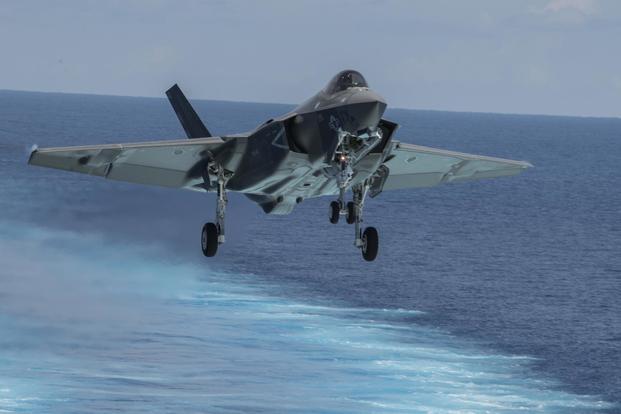Two Navy fighter jets were damaged during an aerial refueling exercise off the coast of Virginia late last month, including an F-35C participating in its first round of operational tests aboard an aircraft carrier.
The F-35C was receiving fuel from an F/A-18F Super Hornet off the coast of Virginia on Aug. 23 when debris from an aerial-refueling basket was ingested into the Joint Strike Fighter jet's engine intake, said Lt. Travis Callaghan, a spokesman for Naval Air Forces.
The mishap led to engine damage for the F-35C, assigned to the California-based "Rough Riders" with Strike Fighter Squadron (VFA) 125. While rare, Callahan said parts of refueling baskets being sucked into an engine's intake are the most common form of non-bird foreign object or debris strikes in the Navy's tactical aviation fleet.
USNI News first reported the mishap.
The incident marked the first Class-A mishap for the Navy's carrier variant of the F-35, which means the aircraft suffered at least $2 million in damages. Damages to the Super Hornet are still being assessed, Callahan said, but it's currently classified as a Class-C mishap, putting estimated damages between $50,000 and $500,000.
One day earlier, an Air Force F-35A pilot from Eglin Air Force Base in Florida encountered an in-flight emergency. When the pilot turned back to return to base, the aircraft's nose gear collapsed following a safe landing.
There were no injuries reported in either aircraft and both landed safely. The F-35C returned to the aircraft carrier Abraham Lincoln and the F/A-18F to Naval Air Station Oceana in Virginia, where it is based with the "Jolly Rogers" of VFA-103.
The incident remains under investigation, Callahan said.
About a half dozen F-35C Lightning II aircraft have been operating aboard the Lincoln for the last month. It's part of the new joint strike fighter's operational tests.
The Navy's F-35 variant, designed specifically for taking off and landing on aircraft carriers, is expected to reach initial-operational capability in February.
-- Gina Harkins can be reached at gina.harkins@military.com. Follow her on Twitter at @ginaaharkins.










